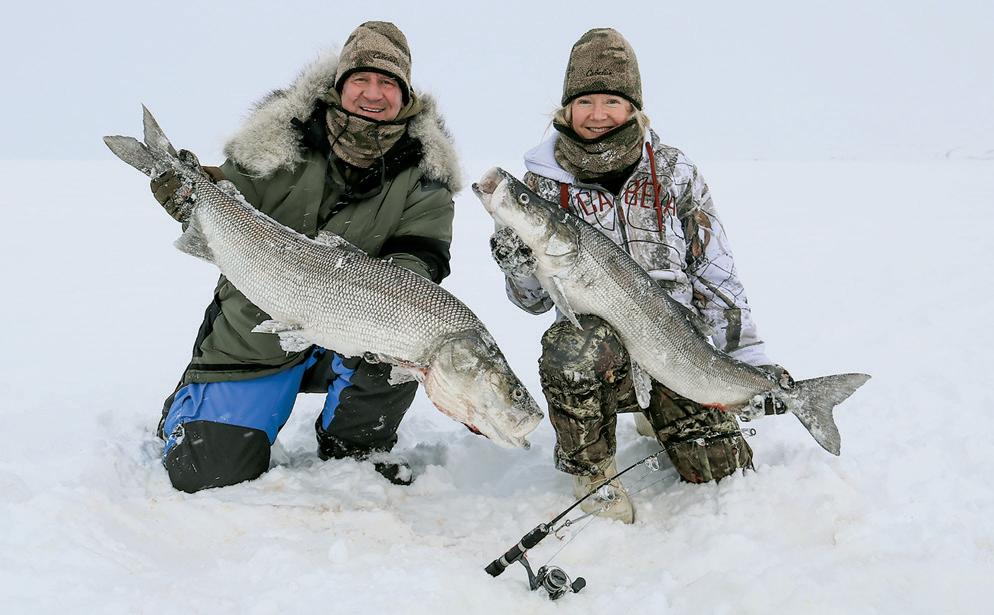
18 minute read
PARTNERS IN LOVE, BUSINESS
FIELD
For nearly a decade early in their married life, Scott and Tiffany Haugen lived in remote Alaska. There and to this day, wild game and fish – like these sheefish taken through 7 feet of ice – are on the daily menu for these outdoor industry professionals and fishing, hunting and cookbook authors. (SCOTT HAUGEN)
FISHING PARTNERS, LIFE PARTNERS
SHARING LOVE OF THE OUTDOORS, EACH OTHER
BY SCOTT HAUGEN
We met in first grade. Our parents grew up together. Our grandparents even knew one another.
I didn’t talk to Tiffany Fountain much during our years in elementary, middle and high school. But we did meet for dinner one evening after graduating from college – her from Oregon State University, me from the rival University of Oregon.
“What are you going to do with your teaching degree?” she asked. “Move to the Alaskan Arctic, where I can teach in a tiny village and learn to hunt and trap with the Inupiat Eskimo peoples,” I replied.
She looked at me and offered, “You better do it now while you’re young and single, because no woman will follow you up there!”
Tiffany had also earned an education degree. Four months later we were engaged. Nine months later we were married and teaching school in one of the tiniest locations on the Arctic coast.
WE’VE BEEN MARRIED NEARLY 32 years and our lives have never slowed down. After teaching in small schools for seven years in the Arctic, we moved to Sumatra, Indonesia, where we taught at an international school for four years. We started our own family and eventually moved back home to Walterville,
FIELD
Snowshoe hare makes for some of the small game world’s best table fare. Using a jar of Rotel tomatoes adds flavor to your recipe. (TIFFANY HAUGEN)
HARE TODAY, GONE TONIGHT

BY TIFFANY HAUGEN
Though Alaska is known as the world of big game, don’t overlook small game, which can be fun to hunt and incredibly good to eat.
When we lived in Anaktuvuk Pass, we trapped, shot and ate snowshoe hare. We’ve hunted them in other parts of the state and always welcome the opportunity to feast on these tasty little critters.
Low and slow or pressure cooked is an ideal way to cook up all cuts of a hare. Because hare is very lean meat, it’s best cooked using a moist-heat method. We don’t cook them whole because they are much easier to cook once segmented. Simply butcher off the saddle, hind and front quarters and put in a slow cooker or pressure cooker such as an Instant Pot.
2 to 3 pounds bone-in or boneless hare meat One 10-ounce jar Rotel diced tomatoes and green chilies* One 6-ounce can tomato paste One medium onion, chopped 4 to 6 cloves garlic, peeled ½ cup water ¼ cup apple cider vinegar 1 teaspoon salt ½ teaspoon black pepper ½ stick butter ¼ cup fresh chopped parsley and/or basil Parmesan cheese if desired
Place hare, Rotel, tomato paste, onion, garlic, water, vinegar, salt and pepper in a slow cooker or pressure cooker. Mix well, coating hare with tomato mixture. In a slow cooker, cook for four to six hours on high or until hare meat falls from bones. In a pressure cooker, set pressure to high and cook 11 minutes for boneless hare and 15 minutes for bone-in hare pieces. Let pressure release on its own before checking for doneness.
When hare is done, remove bones from the meat and add butter and fresh chopped herbs. Let sauce continue to simmer and reduce while making spaghetti noodles. Cook spaghetti according to package directions and add to sauce before serving. Garnish with Parmesan cheese and more fresh herbs if desired. *For more sauce, or a Rotel substitution, use a 14½-ounce can of diced tomatoes and an 8-ounce can of diced roasted green chilies.
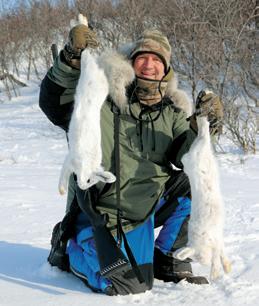
Editor’s note: For signed copies of Tiffany Haugen's popular book, Cooking Big Game, send a check for $20 to Haugen Enterprises, P.O. Box 275, Walterville, OR 97489, or visit scotthaugen .com for this and other titles.
Oregon, east of Eugene. In 1997 I started dabbling in outdoor writing. My first book, Hunting The Alaskan High Arctic, became an all-time best seller for the publisher. By 2001 I felt I could make a living in the outdoor industry as a full-time writer. I made $11,000 that year. But I was forming valuable relationships and soon speaking opportunities and TV hosting jobs came along. The timing was right.
Before I knew it, I was traveling the world hunting and fishing and hosting multiple TV shows. My writing career also boomed. Some years I was in the field over 280 days. Then, when hunting season was over, the speaking circuit began, and that’s where Tiffany came in.
Though Tiff and our two sons joined me on many hunting and fishing trips and were part of the TV shows, it was Tiffany’s ability as a wild game cook that paved her way into the industry. During our time in Alaska we ate only the meat we caught and killed. We ate fish and game every single day. We did – and have always done – our own butchering. With Tiff’s cooking abilities and vast diversity, she was quickly in high demand by companies in the outdoor industry.
Soon we were speaking three months of the year at big events like the NRA Convention and many sport shows around the country. One weekend we’d be in Charlotte, another in Sacramento or Portland, Las Vegas or Nashville, and more. I offered seminars on hunting and fishing techniques, while Tiff gave many on wild game cooking.
But our favorite seminars were when we worked together. Oftentimes whole deer or pigs were brought; we butchered the entire animal, and then Tiff would work her magic, whipping up some great recipes to feed the attendees. To this day she’s the best cook I’ve ever met. We still eat wild game and fish every day. I don’t like going to restaurants because they’re never as good as what Tiffany cooks up.
Together, we’ve written over 20 books, mine on hunting and fishing, Tiff’s on cooking wild game and fish. The cookbooks take the most work. Her popular Cooking Game Birds book was six years in the making; that’s how long it took for her to get things exactly the way she wanted them when it came to wild birds.
When she’s in cooking mode, Tiffany is often preparing a half-dozen recipes a day, and having test cooks replicate recipes, as well as taste-testers give her feedback.
OVER THE YEARS, OUR workload has expanded to include photography, marketing and more. We often work 16 hours a day, each, usually side by side when at home. It’s been far from easy, but I would not change any of it. The times we spend together – as a family butchering a whole elk, deer or bear – are experiences none of us will forget. Traveling the world and filming TV shows in Africa, the South Pacific and Alaska were a blessed opportunity. From the time our boys were small they were hunting, fishing and helping butcher animals.
We got into the outdoor industry at a prime time and just happened to be the team some key companies were looking for. Had we not been able to work with each other all these years, there’s no way I could have done it alone.
One fall, I was home just eight days between the hunting season opener of August 1 and Christmas. Tiff had the hardest part at that time to be home alone with our two young sons. But she always supported me and never questioned the direction we were going.
Each passing year led to more opportunities. When I was on the road, Tiffany was going full speed ahead on her cookbooks, cooking columns and working with many companies in the outdoor industry while developing recipes and cooking equipment, even women’s clothing lines.
I fell in love with Tiffany at our first dinner many years ago because of her confidence and zest for seeking adventure. No challenge is too great for
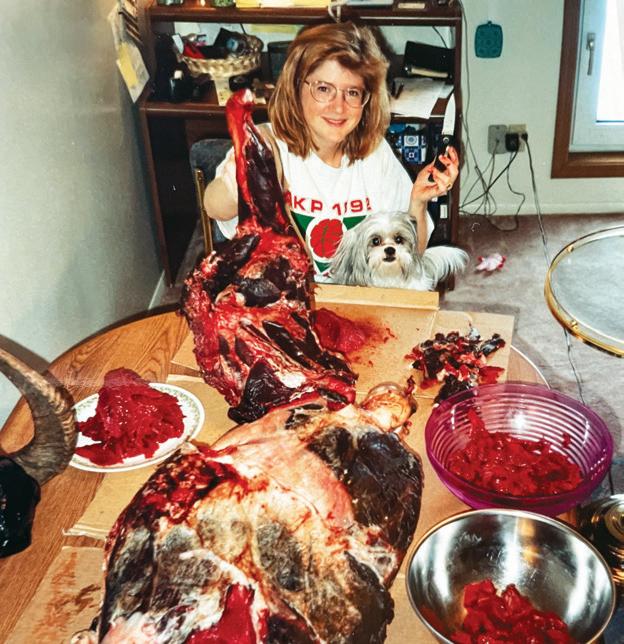
FIELD
The scene: 1995 in Alaska’s Anaktuvuk Pass. Scott had shot a Dall sheep and moose, then flew his girls basketball team to a tournament in Point Hope. They were stranded there by weather for 10 days, and when Scott returned home, he found his wife Tiffany had butchered both animals. Such has been the norm for the Haugens over the past
three decades. (SCOTT HAUGEN)
FIELD
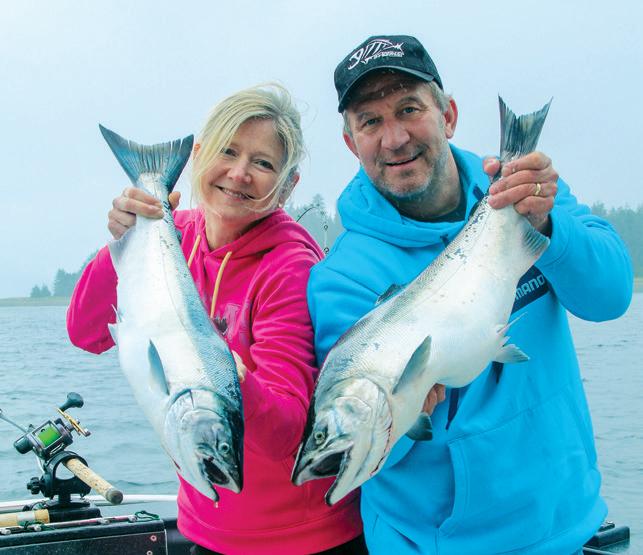
Two years ago Scott and Tiffany lived in Hyder, Alaska, where they enjoyed everything this part of the Last Frontier had to offer, including coho fresh from the sea. They are partners in business and in life as husband and wife and parents of two
sons. (SCOTT HAUGEN) her. Her confidence has never waned, and to this day she’s the hardest-working, most positive person I’ve ever met.
I RECENTLY WAS IN a hunting camp. And while I don’t often share personal stories, the people in this camp were particularly interested in hearing how I am a survivor of a plane crash and a sunken boat in remote Alaska, was charged by a brown bear, covered with leeches in the Australian Outback, and more. “Wow,” one man exclaimed, “that’s mind-boggling to even imagine. So, what’s your greatest fear: drowning, being eaten by a bear, or dying in a plane crash?” he asked. I looked him in the eye. “My greatest fear isn’t dying. My greatest fear is having something happen to my best friend, Tiffany.”
Enjoy this Valentine’s Day and embrace the one you love. ASJ
Editor’s note: For signed copies of Scott Haugen's popular books, visit scotthaugen. com. Follow Scott on Instagram and Facebook.

NOT AFRAID OF THE DARK
A FORMER ALASKAN REMINISCES ABOUT THE COLDEST, SHORTEST DAYS OF THE YEAR
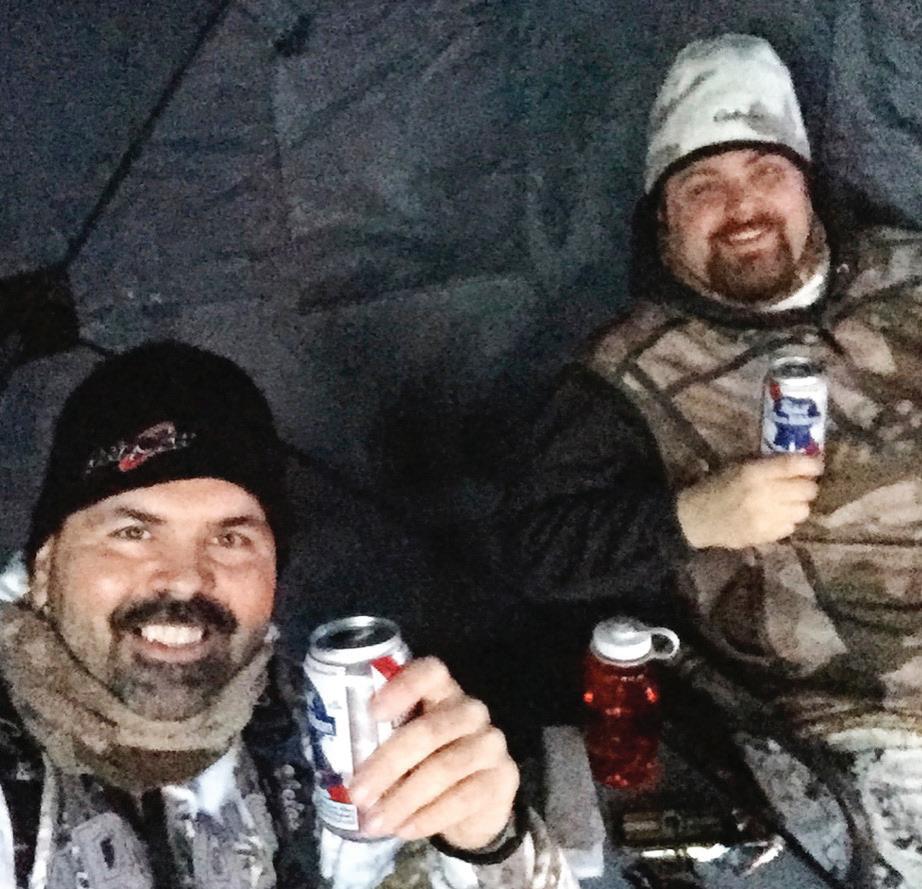
BY PAUL D. ATKINS
Peering through the light of my headlamp was tough in the pitch black, but even more so with a sheet of falling snow hitting me in the face.
My fishing partner Lew was nowhere to be seen, but I could hear him cranking on the old red and white ice auger somewhere in the distance.
“It won’t start?” I yelled. “No, it won’t,” he replied, even though it had started fine before we left the house.
Every pull of the cord produced a little and he kept at it, but to no avail; it just wouldn’t fire for some reason. No worries, though, we had plenty of time. Heck, it was only 4:30 by my watch, just another dark afternoon in northern Alaska.
It’s hard to believe, but I miss that now that I’ve moved away from the Last Frontier. I miss the cold, the dark of the moon on the ice, and especially hanging out with my good friend Lew. I miss the cold rides on snowmachines while bundled in the latest and greatest gear to keep us warm, or at least from freezing to death. I miss seeing my old fishing partner cutting trails and me desperately trying to keep up.
Now I’m back in Oklahoma, where freezing only comes in short spurts and the snow we do get looks alien amongst the hard oaks. It makes me wonder how we did it all back then.

The early days of the year are not ideal and the chances of drilling a hole and catching a fish are pretty much out of the question most of the time. But for former Alaskan Paul Atkins (top, left) and his longtime buddy Lew Pagel, the simple act of heading to the frozen sea and drinking a beer in an ice fishing hut was one way to combat the darkest, coldest days of winter. (PAUL D. ATKINS)
There is truly something magical about the dark days in the Arctic. One is the northern lights dancing in the sky. The way they come in on a cold, dark, clear night makes you tolerate that it’s way
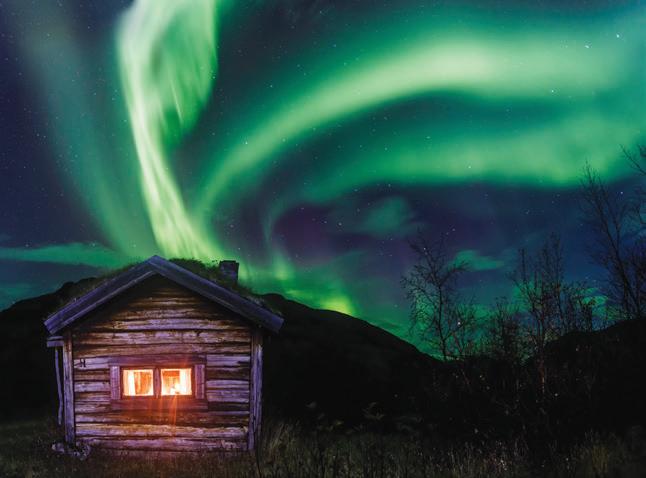
below zero. (PAUL D. ATKINS)
Atkins thinks the time of day when he took this image was around noon, and it shows him following his best friend Pagel back home in the dark and cold, like they did many times over the years. Whether it was for wood, meat or a load of fish, it didn’t matter; they
had fun! (PAUL D. ATKINS) I LOOKED FOR MY bunny boots the other day, but they’re long gone – sold in the garage sale before we left. I wish I still had them. My old black North Face coat, which if you’re a regular reader, you’ve seen in so many of my photos (I went through three of them during my tenure in the Arctic), did come south with me, even though I’ll probably only get to wear it a couple times a year.
I think about this time of year a lot now and it certainly takes me back. I wonder if I was still there, would it be the same? I’m guessing so, and if I did go back, would I be able to fit right back into the routine?
I remember climbing out of bed each morning wondering if the car would start and whether I could find the shovel buried in the enormous snow drift outside. I’m guessing I could if I had to. But it makes me think back to my days in the cold and the dark.
Life in the Arctic during the months of December and January can be depressingly long, cold and boring at times. Without a movie theater, a mall or even an Applebee’s, things can become quite routine, and the thrill of town life isn’t anywhere to be found.
For most people it’s usually work all day, come home, eat dinner and then watch ESPN’s SportsCenter. Ordering from your favorite take-out is about as exciting as it gets, but only if one of the two options is open. If the northern lights are out, then that is a huge bonus.
The Aurora Borealis at least provides some illumination at a time of little to no daylight as well as days of ice fog that is sometimes so dense that you can’t see across the road. On the days when outside temperatures have plummeted through the basement, the urge to dress up in your best cold-weather gear and head outdoors is a chore. But if you can’t manage it, you will go crazy and endure the worst case of cabin fever that sets in and puts you in a bad mood.
But if you’ve lived here long enough like I have, you find ways to keep yourself occupied and not let the dark and cold get you down. Christmastime is the greatest of the holidays, with many celebrations taking place. But most people have a hard time once the darkness sets in. Throughout the late
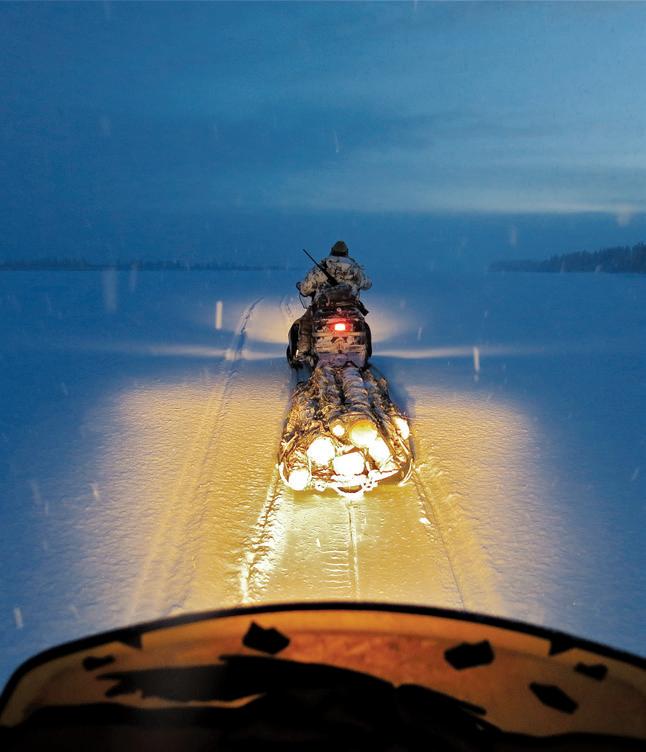
summer and fall leading up to the winter solstice in December, we lose about eight minutes a day of sunlight. At the low point, this results in about an hour of visible daylight, which really isn’t daylight but an eerie hour of dusk. The sun never breaks the horizon and if you don’t notice it, it will pass you by. It can be tough for some.
There are many activities that can break this fever and depressing time. Getting outside, either on foot or a snowmachine, is the key to staying sane. As for me, and many others who call the far north home, these times are actually some of the most rewarding and the best times to be in the Arctic.
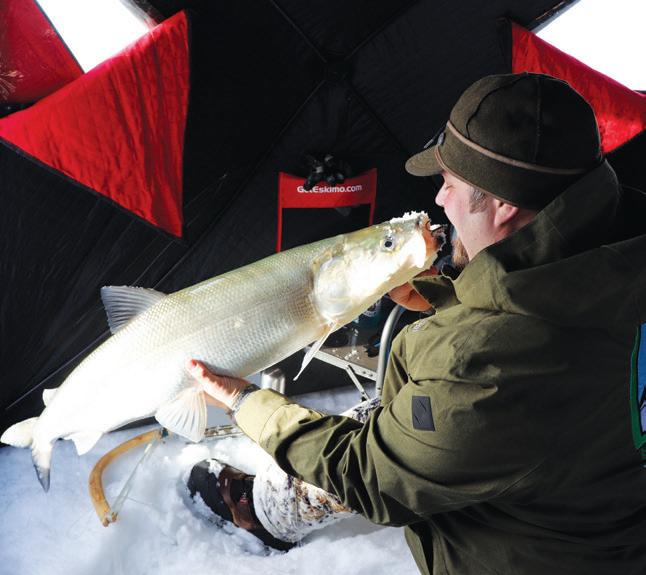
MOST RURAL BUSH ALASKANS go about the winter cycle in different ways; each seems to live by a certain ritual each year. For some, it is a time to hook up the SnoGo and venture off into the wilderness in search of firewood. Ever a staple for
An indoor archery league helped keep Atkins and Pagel sharp for
spring hunts. (PAUL D. ATKINS) Catching sheefish not only helps beat cabin fever, but provides “endless fun and an endless bounty for the freezer.” (PAUL D. ATKINS)
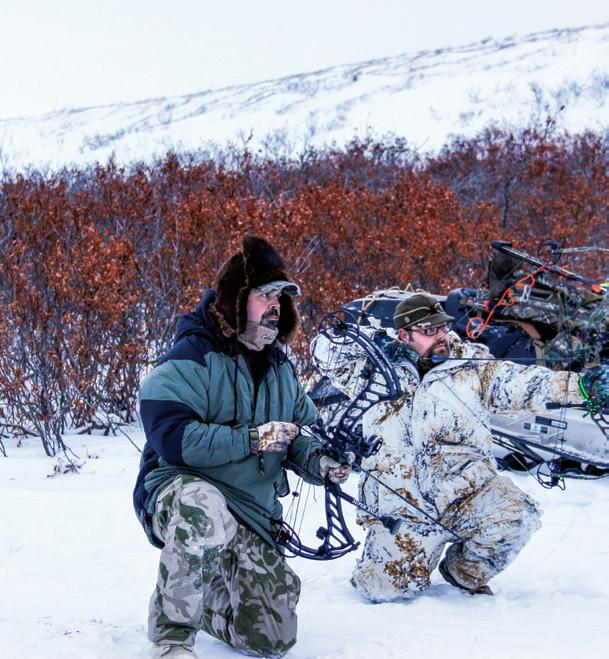
most, having plenty of wood to fill the stove makes them happy and is the key to staying warm, plus it cuts down on the high and ever-increasing fuel bills. Most of the time it is a family affair and everyone eagerly waits to hear the roar of a chainsaw. The key is to start early, which means leaving in the dark and returning in the dark that same afternoon with hopefully a sled full of dead spruce.
Many of us also try to find things that we are passionate about and can do indoors as well as out. Indoor shooting is one of them. Many years ago I started an indoor archery league. Each week a group of us would meet at the school and shoot targets, either for fun or to conduct leagues with scoring systems and prizes at the end of each tournament. This does many things for the psyche; it gives us something to do during the dark days and brings together like-minded individuals to shoot bows and talk about our passion. It also lets us hone our shooting skills, which will be ever so important come spring and fall when we are out hunting and gathering.
In addition, if you’re lucky enough and time everything correctly, you can make it outside for that one hour of light and shoot your bow or maybe even fire off a
This winter, Atkins (left) is in Oklahoma, where winters are far milder, and certainly not as dark. Still, it’s moments like this one that has him feeling so nostalgic. “I wish I was there now,” says Atkins, “hanging out with Lew (right) while sitting in our ice shack drinking beer and hoping a sheefish would rise.” (PAUL D. ATKINS)
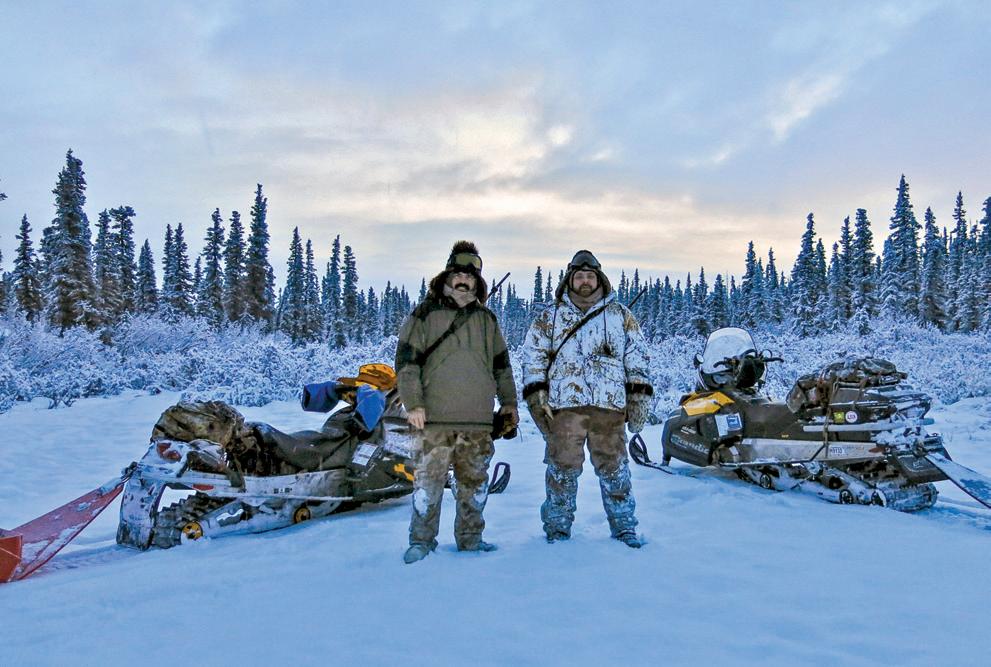
few rounds from your favorite rifle, both high priorities here in the Far North.
OTHER WINTER ADVENTURE SEEKERS have their own passions to pursue in the cold and dark this time of the year. They target the gigantic sheefish that are famous to the area and lay just underneath the frozen ocean. This can break any fever, particularly if the fish are biting, as they can provide endless fun and an endless bounty for the freezer.
There is something truly special about venturing out on the ice in the dark, drilling holes and catching or hooking fish in the cold darkness. If you have an ice hut or shack complete with heat, chairs and maybe a thermos of hot coffee, it can be as grand as any adventure taken in the daylight.
For still others, photography is an avenue to traverse during the winter. Gearing up in cold-weather gear and braving the season’s icy bite is an adventure in itself, but it’s just a part of capturing breathtaking images of what the Arctic has to offer.
Many search for and follow the northern lights, hoping to capture the elusive show in the sky through the camera lens. Some nights are unbelievable, while others not so much. Being able to get out and exercise, plus fill your lungs with that cold night air can be invigorating.
CABIN FEVER IS A disease only if you let it be. Many people in the Lower 48 cannot fathom living in the dark or such cold, for that matter. It is definitely how you perceive it. There are many things to do and most can be as adventurous as any other time in Alaska. The Last Frontier is just that, but for some it is the only place to be throughout the entire year.
We never did get that auger to start that time – and a few times after. Maybe it made too many runs to the ice during the peak months of April and May when it seemed to never get dark. Or perhaps it was the beating it took in the back of the sled while driving a snowmachine down a gravel road when the snow and ice had vanished from the warm days. Who knows? All I know is it was good to be on the ice watching the amazing stars in the night sky, even if it was still late afternoon.
I wish I was there now, hanging out with Lew while sitting in our ice shack drinking beer and hoping a sheefish would rise. We’d be talking football and debating if the Packers could really do it this time and get back to a Super Bowl.
I can’t be there, of course, but all those times before are etched in my memory. It’s something I hold dear to my heart. ASJ
Editor’s note: Paul Atkins is an outdoor writer and author formerly of Kotzebue, Alaska. He’s had hundreds of articles published on big game hunting in Alaska and throughout North America and Africa, plus surviving in the Arctic. His new book Atkins’ Alaska is available on Amazon and everywhere good books are sold. It can also be ordered through paulatkinsoutdoors.com, and if you want an autographed copy, email him at atkinsoutdoors@gmail.com. Paul is a regular contributor to Alaska Sporting Journal.










